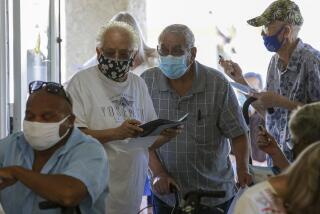Probers to Tell Congress of Widespread Medicare Waste : Health: They will testify unnecessary payments cost program $4 billion a year. A GAO report says that employers, insurers and doctors are to blame.
- Share via
WASHINGTON — Federal investigators will tell Congress today that widespread waste and unnecessary payments are costing the Medicare program at least $4 billion a year.
The General Accounting Office investigators will blame employers and insurance companies for shifting their bills to Medicare and will contend that Medicare pays too much for laboratory services and for work performed in hospitals by radiologists, anesthesiologists and pathologists.
They will also complain that doctors are improperly increasing their incomes through their billing techniques. Medicare, with outlays last year of $106 billion, has become the fourth-largest federal spending program, surpassed only by defense, Social Security and interest on the national debt.
“It is vital to ensure that Medicare payments are not excessive or inadequate . . . because the program serves as a national guide to other health care payers who often follow Medicare’s lead,” says the GAO report, which will be presented today to the health subcommittee of the House Ways and Means Committee. A copy of the report was obtained by The Times.
Richard Kusserow, inspector general of the Department of Health and Human Services, who also will testify today, will tell the committee that doctors are improperly boosting their charges to Medicare by “unbundling,” or making separate claims for what is really a single procedure. In a hysterectomy, for example, he said that doctors may charge separately for “exploration of the abdomen, removal of ovaries and tubes and removal of scar tissue.”
“These types of (billing) techniques can result in undeserved payments of millions of dollars,” according to a copy of Kusserow’s prepared testimony.
One of the biggest areas of unnecessary spending, according to the GAO and Kusserow, involves companies that employ workers enrolled in Medicare. The federal health program covers 30 million Americans over 65, and 3 million disabled people of all ages.
Federal rules require that businesses providing health insurance pay their workers’ medical bills first, with Medicare as the secondary source of payment. But many firms ignore this rule, costing Medicare at least $1.3 billion a year, the report says.
Medicare, which helps pay hospital and doctor bills, also provides for reimbursement for services at teaching hospitals where doctors are trained. These extra payments “are too high,” giving the teaching institutions much higher profit margins than other hospitals, according to the GAO report. The GAO believes that these payments should be cut by $840 million. Kusserow puts the figure at $1.3 billion.
The GAO says that Medicare could save $50 million a year by reducing payments for anesthesia services and $150 million by trimming rates of payment for laboratory diagnostic reports.
“Although Medicare payment rates for clinical diagnostic laboratory services provided by independent laboratories have been reduced, payments for such services are still too high,” according to the GAO. The five biggest laboratories have a profit rate on Medicare patients that is 11% higher than the overall profit rates for their business, the GAO says.
Kusserow says that Medicare could save $400 million a year by reducing its payments for laboratory work to levels “comparable to what doctors are paying for the same tests.”
The GAO says that Medicare is spending too much for services from new, high-technology equipment and too much for surgery performed in hospitals on patients who do not stay overnight.
Starting in 1983, Medicare adopted a system of fixed payments for treatment of patients in hospitals, drastically slowing the rate of inflation in hospital costs.
Even in this area, however, savings are possible, Kusserow says. If Medicare can stop hospitals from incorrectly classifying patients’ illnesses to collect higher payments, the government could save $474 million a year, the inspector general says.
Increasingly, surgeries are now done on an outpatient basis--where the patient comes for an hour or two, has the operation and goes home. The GAO says that Medicare is paying too much for these surgeries.
The government also could save about $300 million by reducing the multiple payments to physicians who visit more than one patient at a nursing home, according to Kusserow.
More to Read
Get the L.A. Times Politics newsletter
Deeply reported insights into legislation, politics and policy from Sacramento, Washington and beyond. In your inbox twice per week.
You may occasionally receive promotional content from the Los Angeles Times.










